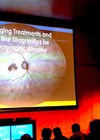Wet (exudative or neovascular) age-related macular degeneration (AMD) is characterised by choroidal neovascularisation, in which new blood vessels from the choroid invade through Bruch’s membrane. These blood vessels proliferate beneath or through the retinal pigment epithelium (RPE), causing patients to primarily report visual changes such as distortion or blurred vision.
In the UK, neovascular AMD (nAMD) is the leading cause of irreversible blindness and visual impairment in patients over 60 years old [1]. Despite nAMD only accounting for 10% of all AMD cases, wet AMD accounts for 90% of blind registration in the UK with approximately 40,000 new cases every year [2]. The associated rise in life expectancy worldwide is expected to dramatically increase the incidence of wet AMD.

Currently, nAMD is managed through a mainstay of anti-vascular endothelial growth factor (anti-VEGF) intravitreal injections and photodynamic therapy (PDT). New treatments are required to deal with incoming disease burden by offering more therapeutic results and differing modes of administration.
In this article, we explore five emerging alternatives to manage and treat nAMD in a range of administration modalities.
1. RGX-314 gene therapy
RGX-314 gene therapy is being posited as a novel one-time gene therapy for nAMD employing an Adeno-associated virus (AAV-8) vector that encodes an antibody designed to inhibit VEGF. The AAVIATE’s phase 2 trial of RGX-314 demonstrated suprachoroidal drug delivery at three different doses across five cohorts. All patients had received previous intravitreal anti-VEGF injections.
The primary goal was to evaluate the mean change in the best corrected visual acuity (BCVA) with the study drug compared with monthly ranibizumab injections at nine months. The secondary goals were to determine the safety / tolerability of ABBV-RGX-314, measure the changes in the central retinal thickness (CRT), and determine the need for anti-VEGF rescue treatment.
The drug was well tolerated by all patients. Retinal thickness and vision were stable in patients receiving ABBV-RGX-314 at all dose levels. The highest-dosing patients in cohort four saw an 85% decrease in the annualised rate of injections with anti-VEGF therapies, and 67% of patients remained injection-free after six months.
Topical corticosteroids resulted in the resolution of intraocular inflammation in cohorts one through three, with mild inflammation and a similar incidence observed across doses; cohort four, which received dose three, had mild-to-moderate inflammation with an increased incidence over the previous doses.
A phase 3 trial is currently underway, and the study is expected to be completed in December 2025 [3].
2. SB-11 biosimilars
SB-11 is a biosimilar of ranibizumab (anti-VEGF), offering patients the advantage of increased affordability and a wider array of options in managing their condition. The study’s primary efficacy endpoints focused on changes in baseline optical coherence tomography (OCT) central subfield thickness (CST) and BCVA at the 52-week mark [4].
The SB-11 phase 3 trial (n=705) reported a change in baseline BCVA of 9.8 letters for SB-11 and 10.4 letters for Ranibizumab at week 52. In addition, comparable incidence of serious ocular treatment emergent adverse events (SB-11: 2.9% and Ranibizumab: 2.3%).
A reduction in CST was noted in the SB11 group of 140 microns compared to 125.1 microns in the Ranibizumab group, which demonstrated equivalence in primary efficacy. Biosimilars can help lower healthcare costs and increase patient access to approved therapies, as demonstrated by experience in other medical specialties. Ranibizumab biosimilars have the potential to decrease undertreatment in nAMD and enhance visual outcomes in the clinical practice setting.
3. Opt302 (Sozinibercept)
Unlike traditional intravitreal therapies like ranibizumab, bevacizumab, and aflibercept, which primarily inhibit VEGF-A, OPT-302 (Sozinibercept) is a biologic inhibitor of VEGF-C and -D. To evaluate OPT-302’s safety and effectiveness in conjunction with ranibizumab (an anti-VEGF-A inhibitor) a phase 2b trial was conducted. Three groups containing 0.5mg of OPT-302, 2.0mg of OPT-302, and sham were created out of a total of 366 participants. The mean change in BCVA at week 24 from baseline was the main outcome of this trial.
A significant difference was observed between the 2.0mg OPT-302 group’s mean (± standard deviation) visual acuity gain and the sham group (+14.2 ± 11.61 vs. Letter P=0.01; +10.8 ± 11.52). There was no significant difference found between the 0.5mg OPT-302 group and the sham group (+9.44 ± 11.32 letters; P=0.83). Secondary BCVA results showed that the 2.0mg OPT-302 group performed better than the sham group, and structural results showed that both OPT-302 dosage groups performed better. Adverse events (AEs) were similar in the lower-dose, higher-dose, and sham groups, with at least one major AE occurring in 16 (13.3%), seven (5.6%), and 10 (8.3%) participants, respectively. Two unrelated deaths both occurred in the sham arm.
Opthea have launched a two-year, phase 3 trial with over 990 individuals and is expected to finish in December 2024 [5]. This trial aims to provide valuable insight into the longer-term safety and efficacy of OPT-302.
4. AKST4290
AKST4290 is a novel, orally administered treatment for nAMD. AKST4290 is a small molecule antagonist of human chemokine receptor 3 (CCR3), which has proved to play an important role in the formation of choroidal neovascularisation (CNV) [6].
Two distinct phase 2a clinical trials for AKST4290 in nAMD were done: one in treatment naïve patients and one in refractory nAMD patients. Notably, in the treatment naïve cohort (n=30), the mean BCVA gain was seven letters, with 83% of eyes achieved maintenance or improvement in BCVA.
At week six, 73% of eyes in the refractory nAMD cohort (n=26) experienced maintenance or improvement in BCVA and a mean BVCA again of two letters.
Although the formal announcement of a phase 3 trial exploring AKST4290 is pending, the positive outcomes from the two phase 2a clinical studies suggest a promising avenue for reducing treatment burden through the oral administration of this innovative treatment.
5. RBM-007 (Umedaptanib pegol)
RBM-007 represents an innovative intravitreal approach to nAMD, targeting fibroblast growth factor-2 (FGF2). FGF2, recognised as an angiogenic growth factor predating VEGF, has exhibited superior angiogenic activity in murine studies [7].
The preliminary SUSHI study (n=9) constituted a non-controlled, dose-escalating phase 1/2a clinical investigation, administering 0.2, 1, and 2mg / eye doses. All dosing conditions were well tolerated by the nine participants, with seven of them experiencing vision gain or >50μm improvement in CRT subsequent to inadequate response to prior anti-VEGF therapy.
Building upon these promising outcomes, the subsequent TOFU study (n=86) represented a phase 2 trial with three distinct treatment arms. This study evaluated the safety, efficacy, and durability of four monthly intravitreal injections of RBM-007 monotherapy (arm 1), four monthly RBM-007 injections in combination with Eylea (arm 2), and Eylea monotherapy administered every other month (arm 3). At the 16-week primary endpoint, results indicated comparable BCVA (-4.8 ±2.17 vs. -1.2 ± 1.82) and CST between arms 1 and 2, suggesting the effectiveness of RBM-007 in preventing disease progression and its non-inferiority to Eylea.
At the time of writing, the formal announcement of a phase 3 trial for RBM-007 remains pending.
Conclusion
Promising outcomes from ongoing trials showcase the potential of these alternatives to not only maintain or improve visual acuity but also address the issue of treatment burden. RGX-314’s one-time administration, SB-11’s biosimilar equivalence, OPT-302’s unique biologic inhibition, AKST4290’s oral administration, and RBM-007’s targeting of FGF2 present diverse avenues for enhanced patient outcomes. These findings contribute to the evolving landscape of wet AMD management, offering valuable insights into the comparability, safety, and efficacy of these novel interventions.
The ongoing phase 3 trials, such as those for RGX-314, SB-11, and OPT-302 hold the promise of further elucidating the long-term implications and global applicability of these emerging treatments. As we eagerly await the outcomes of these investigations, it is clear that these alternatives hold substantial potential for reshaping the therapeutic landscape and improving the lives of individuals affected by wet AMD.
References
1. Klein R, Klein BE, Jensen SC, et al. Age-related maculopathy in a multiracial United States population: the National Health and Nutrition Examination Survey III. Ophthalmology 1999;106(6):1056–65.
2. Owen CG, Jarrar Z, Wormald R, et al. The estimated prevalence and incidence of late stage age related macular degeneration in the UK. Br J Ophthalmol 2012;96(5):752–6.
3. Pivotal 2 study of RGX-314 gene therapy in participants with NAMD (2023). ClinicalTrials.gov.
https://classic.clinicaltrials.gov/
ct2/show/NCT05407636
4. Bressler NM, Veith M, Hamouz J, et al. Biosimilar SB11 versus reference ranibizumab in neovascular age-related macular degeneration: 1-year phase III randomised clinical trial outcomes. Br J Ophthalmol 2023;107(3):384–91.
5. OPT-302 With Ranibizumab in Neovascular Age-related Macular Degeneration (nAMD) (ShORe) (2023). ClinicalTrials.gov.
https://clinicaltrials.gov/study/
NCT04757610
6. Wu XW, Liu ZL. Study progress of CCR3 in wet age-related macular degeneration. Int J Ophthalmol 2014;14(3):457–9.
7. Birsner AE, Benny O, D’Amato RJ. The corneal micropocket assay: A model of angiogenesis in the mouse eye. J Vis Exp 2014;(90):51375.
[All links last accessed November 2023]
Declaration of competing interests: None declared.
COMMENTS ARE WELCOME











